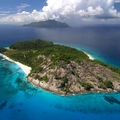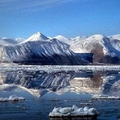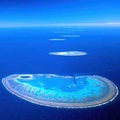World Tourism / The Oceans of the World / The Indian Ocean
The Indian Ocean
About the Indian Ocean
The Indian Ocean is the third largest ocean in the world and it covers 73 million square kilometers. This is the warmest ocean, rich in various flora and fauna. The deepest place in the Indian Ocean is the Java basin, located south of the island of Java. Its depth is of 7450 m. It is interesting that the currents in the Indian ocean are changing their direction twice a year. In winter, the prevailing monsoons are forwarded to the coast of Africa , and in summer to the shores of India.
General information
The Indian ocean is positioned between the West Africa, Australia and the Sunda Islands in the East, Asia in the north and Antarctica in the south. The Indian Ocean includes the Red, the Arabian and the Andaman Sea, the Gulf of Aden, the Gulf of Oman, the Persian and the Bay of Bengal. The Indian Ocean has in its possession many islands as Madagascar ( the fourth largest island in the world), the Comoros, the Seychelles, the Maldives, the Mauritius, Sri Lanka. Indonesia is bordered by the ocean to the east. Until the XVIII century, the ocean was inaccessible to the Europeans, until the map of the Indian Ocean was bought.
The underwater world of the Indian Ocean
The underwater world of the Indian Ocean is unusually rich. The waters of the ocean are inhabited by mussels, squid, crabs and lobsters. There are fishes, parrots, surgeons, flying fish and poisonous lionfish. Typical inhabitants of the ocean are the Nautilus, echinoderms, corals and crossopterygians. The Indian Ocean has more than 15 species of sharks. The value of the Indian Ocean for global fisheries is small: only 5% of the total. The main commercial fish caught here are: tuna, sardines, anchovy, a few species of sharks, barracudas, grays, shrimps, lobsters and crayfish.
Facts and Figures
Area: 76.17 million sq. km
The maximum width: 9975 km
The average depth: 3711 m
The maximum depth: Sunda Trench (7729 m)
Mineral resources: oil, natural gas, marine fisheries: fish (sardines, mackerel and squaloid species), mollusks
The largest island: Madagascar
Description
The Indian Ocean stretches from the shores of East Africa to Indonesia and Australia, and from the shores of India to Antarctica. These include the Arabian Ocean and the Red Sea, as well as Bengali and the Persian Gulf. The Suez Canal connects the northern part of the Red Sea to the Mediterranean. There are huge areas of the earth's crust at the bottom of the Indian Ocean on the African plate, the Antarctic plate and the Indo-Australian plate. Shifts of the earth's crust cause underwater earthquakes that cause giant waves called tsunamis. As a result of earthquakes new mountain ranges appear at the bottom of the ocean. In some places, undersea mountains protrude above the water surface, forming the most scattered islands in the Indian Ocean. Deep depressions lie between the ridges. For example, the Sunda trench depth is about 7450 meters. The Indian Ocean is home to various wildlife species, including corals, sharks, whales, turtles and jellyfish. Strong currents are huge flows of water moving through the warm blue Indian Ocean area. The Western Australia is within the cold Antarctic waters to the north to the tropics. The equatorial current, located below the equator and the warm water circulates clockwise. The northern flow is dependent on the heavy downpours of monsoon winds that change the direction depending on the season.
People and history
Seafarers and traders plied the waters of the Indian Ocean many centuries ago. The main trade routes were the ships of the ancient Egyptians, Phoenicians, Persians and Indians. Settlers from India and Sri Lanka crossed the southeast of Asia in the early Middle Ages. Wooden ships called dhou sailed the Arabian Sea from ancient times, which transported exotic spices, African ivory, and fabric. In the XV century, the great Chinese navigator Female Ho led a great expedition across the Indian Ocean to the shores of India, Sri Lanka , Persia, Arabia and Africa. In 1497, the Portuguese navigator Vasco da Gama became the first European ship which skirted the southern tip of Africa and reached the shores of India. It was followed by the British, the French and the Dutch traders, and the era of colonial conquest. New settlers, traders and pirates landed on the islands of the Indian Ocean for centuries. Many species of island animals did not live anywhere else in the world, they became extinct. For example dodo, the flightless pigeon-sized goose, in Mauritius , was destroyed by the end of the XVII century. Giant tortoises on the island of Rodrigues disappeared to the XIX century. The study of the Indian Ocean continued in the XIX and the XX centuries. Scientists did a great job mapping the topography of the seabed. Currently running on orbit satellites produce images of the ocean, measured by its depth and transmit information messages.
The Indian Ocean-Tourist Paradise
Being extremely warm almost any time of year, the water attracts numerous tourists. Travel companies have been offering holidays at the best resorts in the Indian Ocean. There are also cruises. This kind of recreation has marvelous service and with nothing comparable climate. The landscapes capture the imagination of impressionable tourists, the sunsets of the Indian Ocean are of particular attention. Visitors are actively photographing beautiful views, show off in front of one another particularly successful pictures of the ocean. Even the 2007 tsunami did not diminish the number of tourists. Besides the ocean, the tourists are interested in the sightseeing places of India, particularly Bollywood, where well-known Indian films are starred.
Others The Oceans of the World .
Maps of The Indian Ocean
mapOthers from The Oceans of the World
Life depends crucially, more than ever, on the respect that people will have to the oceans.
They are and will remain the cradle of life.
A romance voyage with saturated air, breathing the sea air is a necessary condition for a quality rest.
This improves the immunity of the person and receives a charge of vivacity enough for a few months.
The sea air, rich in iodine salts, sodium chloride promotes cell regeneration and the slowing of the aging process.
The sea calms, the sound of the waves, and the vast expanse of the water that a person can watch endlessly is good for our health.
When combined with new experiences, excursions and trips, sea and ocean tours give a great therapeutic effect.
The oceans and the seas, the rivers, the lakes and the streams cover 75% of the surface of our planet.
The amazing underwater world attracts many travelers.
In the past, a travel was associated with the seas and oceans.
Geographical discoveries are inextricably linked with the travelers.
The world knows them since the Middle Ages and starting the list with Columbus and ending with Heyerdalom and Jacques-Yves Cousteau.
Hydrosphere is the collection of all water bodies of the world: oceans , rivers , lakes , reservoirs, wetlands, groundwater, glaciers.
Water is the basis of the hydrosphere, one of the most common chemical compounds on the Earth.
This is the only substance that under natural conditions on the surface of our planet is found in solid, liquid or gaseous state.
It is the main component of the living organisms.
Water body is the permanent or the temporary concentration of the natural waters on the land surface or in rocks with distinctive forms of distribution and features of the regime.
Water bodies are the seas, oceans, rivers, lakes, marshes, reservoirs, groundwater, and water channels, ponds and other places of constant concentration of water on the land surface (in the form of snow).
The world ocean is the bulk of the hydrosphere, a continuous aqueous envelope of the earth surrounding the continents and islands distinguished by a salt composition.
The oceans are regulators of the heat.
Oceans are rich in food, mineral and energy resources.
The boundaries between oceans have been established by the International Hydrographic Organization , so the Antarctic Ocean coast extends from Antarctica to 60 degrees latitude.
One billion people ( 17% of the population) depend directly on the ocean as the only source of protein.
Between 70 – 80% of oxygen is produced by the oceans.
The word ocean from the Greek “ Ωκεανός” , on behalf of the Greek god of the Ocean is the largest water body, a component of the World Ocean , located among the continents , which has a system of water circulation and other special features.
The surface area of the world's oceans, which consist of oceans and seas is about 75 % of the surface of the Earth (about 361 million square kilometers).
The science that studies the oceans is called oceanography .
In 2000, the International Hydrographic Organization adopted a division into five oceans of the world .
However, later on the provision of a separate Southern Ocean refused, and it is now officially back on the Earth’s four oceans: The Atlantic Ocean Area: 91 million km 2 Size: 329.
7 million km 3 Average depth: 3600 meters Maximum depth: 8742 meters The Indian Ocean Area: 73 million km 2 Volume: 292.
1 km 3 Average depth: 3890 meters Maximum depth: 7725 meters The Arctic Ocean Area: 14 000 000 km 2 Volume: 18.
1 km 3 Average depth: 1225 meters Maximum depth: 5527 meters The Pacific Ocean Area: 169 million km 2 Size: 710 km 3 Average depth: 4280 meters Maximum depth: 11 022 m The largest of these is the Pacific Ocean, an area of approximately 169 million square km, the Atlantic Ocean, which area is 91 million square km is the third largest ocean, the Indian and the smallest ocean - the Arctic, an area of approximately 14 million square km.
The oceans are deep waters.
If the surface of the ocean is warmed up by the sun, at the depth, its temperature can fall and fall , even below -1 C.
The water in all parts of the vast ocean is never quiet, constantly moving.
Such movements of the water over long distances are called currents.
The currents are of several types: superficial, deep and bottom.
The main reason for the surface currents (drift) is a breeze.
The sun, the chemical transformations and the attraction of the moon are reasons for the movement of water in the ocean.
The colder or the saltier water .
So, for example, when dealing with warm water, the cold goes into the depths.
Thus deep and bottom currents can be formed.
The Russian Admiral Makarov scientist discovered in the XIX century an undercurrent in the Bosporus.
He found that the more saline waters of the Marmara Sea flows into the Black Sea current , less saline water is carried by the current from the Black Sea of Marmara.
There are ocean currents that arise due to the inclination of the sea level.
These include, in particular, to Florida for the Caribbean, which is formed as a result of the surge of the water over the surface in the Gulf of Mexico.
We cannot know the answer to the question about the formation of the seas and oceans on the planet.
Some scholars suggest that they arose in the following way.
After the appearance of the planet, the Earth was surrounded by a thick blanket of clouds.
Gradually, the Earth cooled and long rains poured on the surface, which filled with water all the cavities in the earth's crust.
Thus, the oceans and the seas were formed.
Later, when the continents began to move, all moving from each other, the water began to fill the distance between them.
So they formed the oceans, which are available now.











